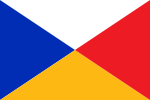MS Pride of Dover
| Pride of Dover leaving Dover in 2006 | |
| History | |
|---|---|
| Name: |
|
| Owner: |
|
| Operator: |
|
| Port of registry: |
Dover, |
| Route: | Dover-Calais |
| Builder: | Schichau Unterweser AG, West Germany |
| Cost: | approx £42 million[2] |
| Yard number: | 93 |
| Laid down: | 9 April 1986 |
| Launched: | 20 September 1986 |
| Completed: | 27 May 1987 |
| Maiden voyage: | 2 June 1987 |
| In service: | 2 June 1987 |
| Out of service: | 15 December 2010 |
| Identification: | IMO number: 8517736 |
| Fate: | Scrapped |
| Status: | Out of Service |
| General characteristics | |
| Tonnage: | 26,433 GT |
| Length: | 169.6 m (556.4 ft) |
| Beam: | 28.27 m (92.7 ft) |
| Draft: | 6.12 m (20.1 ft) |
| Installed power: | 3 x Sulzer ZA40S Diesels |
| Propulsion: | Triple controllable pitch propellers |
| Speed: | 22 kn (41 km/h) |
| Capacity: |
|
MS Pride of Dover was a cross-channel ferry built in 1987 for Townsend Thoresen. She mainly operated the Dover–Calais route for P&O until 2010.
History
Pride of Dover was the last new ship to appear in service with the famous Townsend Thoresen orange hull, although she was delivered with the Peninsular and Oriental Steam Navigation Company (P&O) house flag painted on her funnel in place of the traditional 'TT' insignia. Townsend Thoresen was renamed P&O European Ferries late in 1987, following the Herald of Free Enterprise disaster, and Pride of Dover was swiftly repainted in the new company colours.
Pride of Dover primarily operated the Dover–Calais route, but on a number of occasions made crossings between Dover and Zeebrugge as a result of industrial action in France.
The industry generally regarded Pride Of Dover and her sister Pride of Calais as the most successful ferries ever built for English Channel service. The ships boasted superb handling characteristics and excellent sea-keeping abilities. Between 1998 and 2002 she was under the control of P&O Stena Line and carried the name P&OSL Dover from 1999 until 2002. Once returned to P&O control she was renamed PO Dover before she was repainted into new P&O Ferries livery when her name returned to Pride of Dover.[2]
The vessel ended her P&O service on 15 December 2010 with her last crossing leaving Dover at 2345 local time. She was replaced by the new superferry Spirit of Britain, with a bigger capacity and almost double the gross tonnage, at 47,600 tons, the second largest ferry to cross the channel.[3] Pride of Dover was laid up in Tilbury Docks and offered for sale. In February 2012, her house flag was removed from her funnel, but she remained in warm lay-up in Tilbury until 23 October 2012, when Pride of Dover was put into cold lay-up. All her generators were switched off and her skeleton crew was transferred to her sister, Pride of Calais, which was laid-up in Tilbury on that day.
On 1 November 2012, almost two years after she had been laid up, Pride of Dover, with her engine damaged beyond repair, was reported sold for scrap to German shipping interests.[4] Her name was changed to Pride and all her P&O logos were removed. On 29 November, she left Tilbury for Tuzla, Turkey in tow of tug Eide Fighter,[2] but was delivered to Aliağa on 27 December.
Onboard
As with most P&O Ferries, the Pride of Dover had the following onboard services:
- The Food Court – self-service restaurant (formerly International Food Court)
- Langan's Brasserie – Restaurant
- Offshore Shopping
- The Bar (formerly Silverstones Sports Bar)
- Harbour Coffee Company – Coffee Shop
- Several lounges
- Club lounge
- Quiet lounge
- Truckers lounge
- Horizon lounge
- Amusement arcade
Deck layout
- A deck was crew space
- B deck was passenger and crew space
- C deck was passenger space
- D deck was a mezzanine car deck
- E deck was the top main car deck
- F deck was the lower mezzanine deck
- G Deck was the lower main car deck
- H Deck was the location of the engine control room and storage.
New rules in the late 1990s meant that deck letters were replaced with numbering, where Deck 1 was the lowest part of the vessel, and, in the case of the Pride of Dover, Deck 10 was the topmost deck – previously referred to as the "monkey island deck" or M Deck.
- Deck 1 – Lower Engine Room (Previously Tank Top)
- Deck 2 – Upper Engine Room & Stores (Previously H Deck)
- Deck 3 – LVD (Lower Vehicle Deck)
- Deck 4 – Lower Mezz Decks
- Deck 5 – UVD (Upper Vehicle Deck)
- Deck 6 – Upper Mezz Decks
- Deck 7 – Passenger Spaces (Previously C Deck)
- Deck 8 – Passenger and Crew Areas (Previously B Deck)
- Deck 9 – Crew Areas (Previously A Deck)
- Deck 10 – Monkey Island (Previously M Deck)
Sister Ship
- MS Pride of Calais built 1987
References
Notes
- ↑ Rabson, Stephen; O'Donaghue, Kevin (1988). P&O: A Fleet History. Kendal: World Ship Society. p. 524. ISBN 0-905617-45-2.
- 1 2 3 "MV Pride of Dover - Past and Present". Dover Ferry Photos. Retrieved 1 December 2012.
- ↑ "Spirit of France and Spirit of Britain". P&O Ferries. Retrieved 1 December 2012.
- ↑ http://www.doverferryphotosforums.co.uk/wordpress/mv-pride-of-dover-past-and-present/
Bibliography
- Hendy, John (2015). Remembering the Chunnel Beaters: The Pride of Dover and the Pride of Calais. Ramsey, Isle of Man: Ferry Publications. ISBN 9781906608842.
